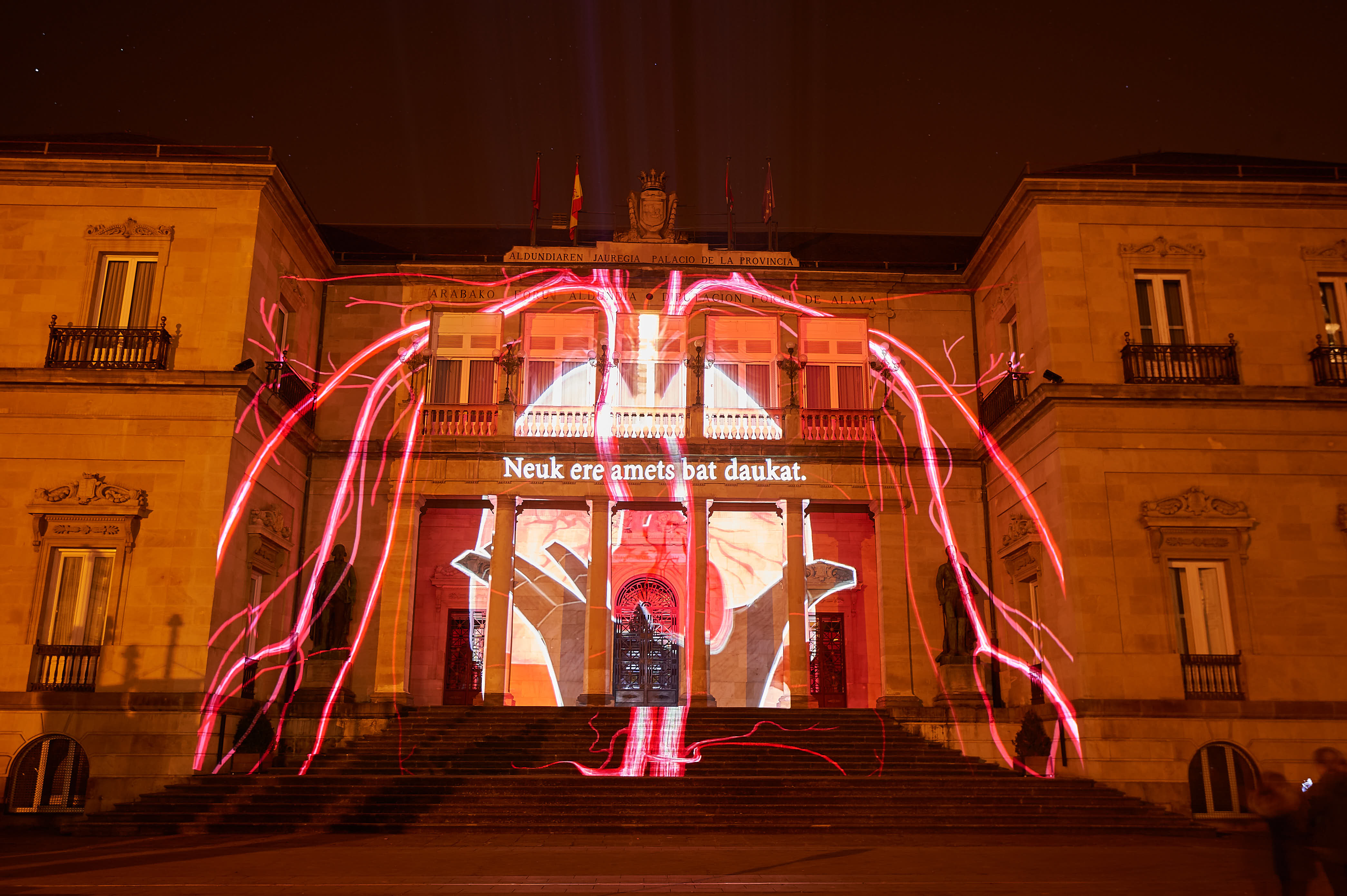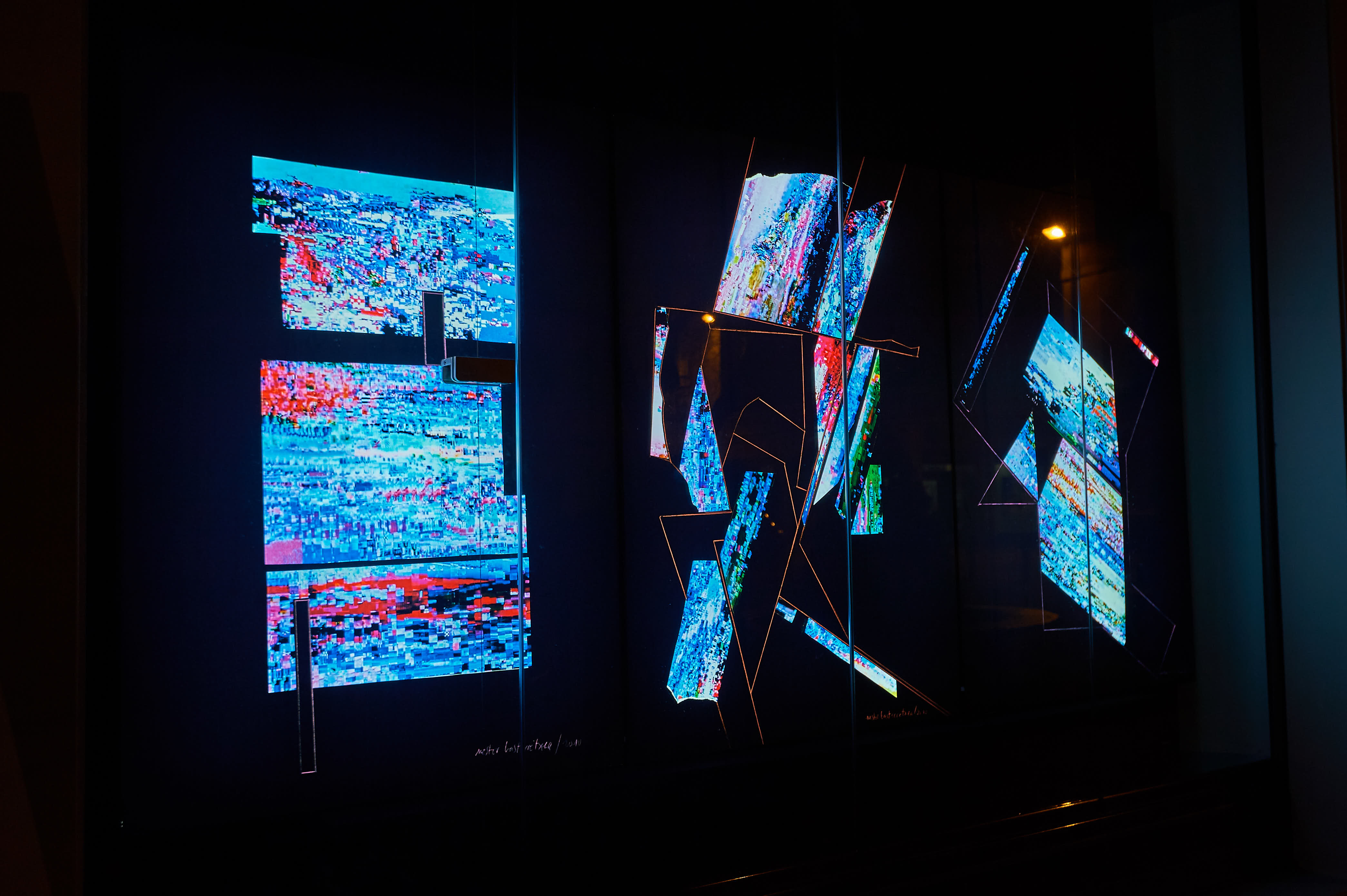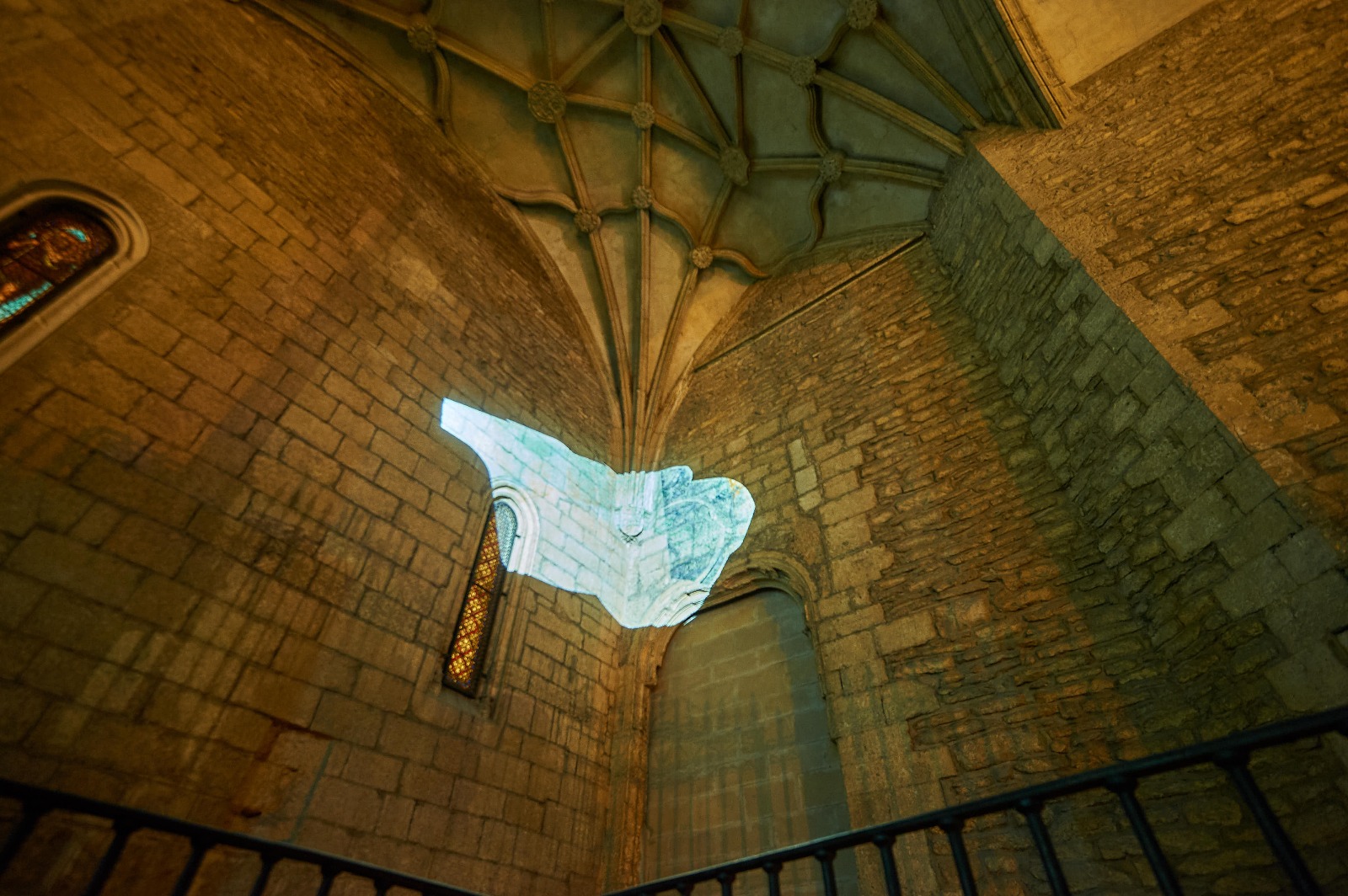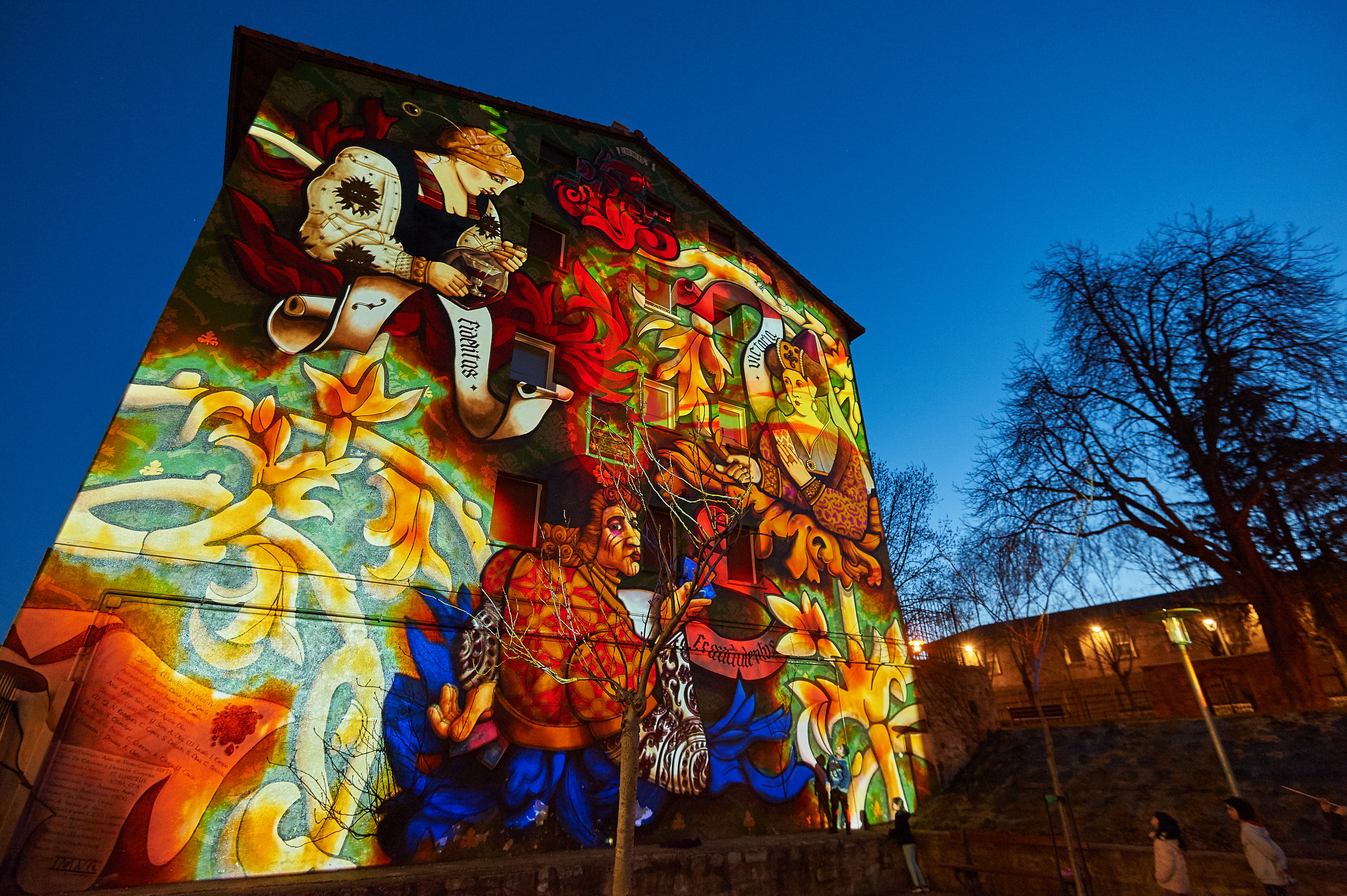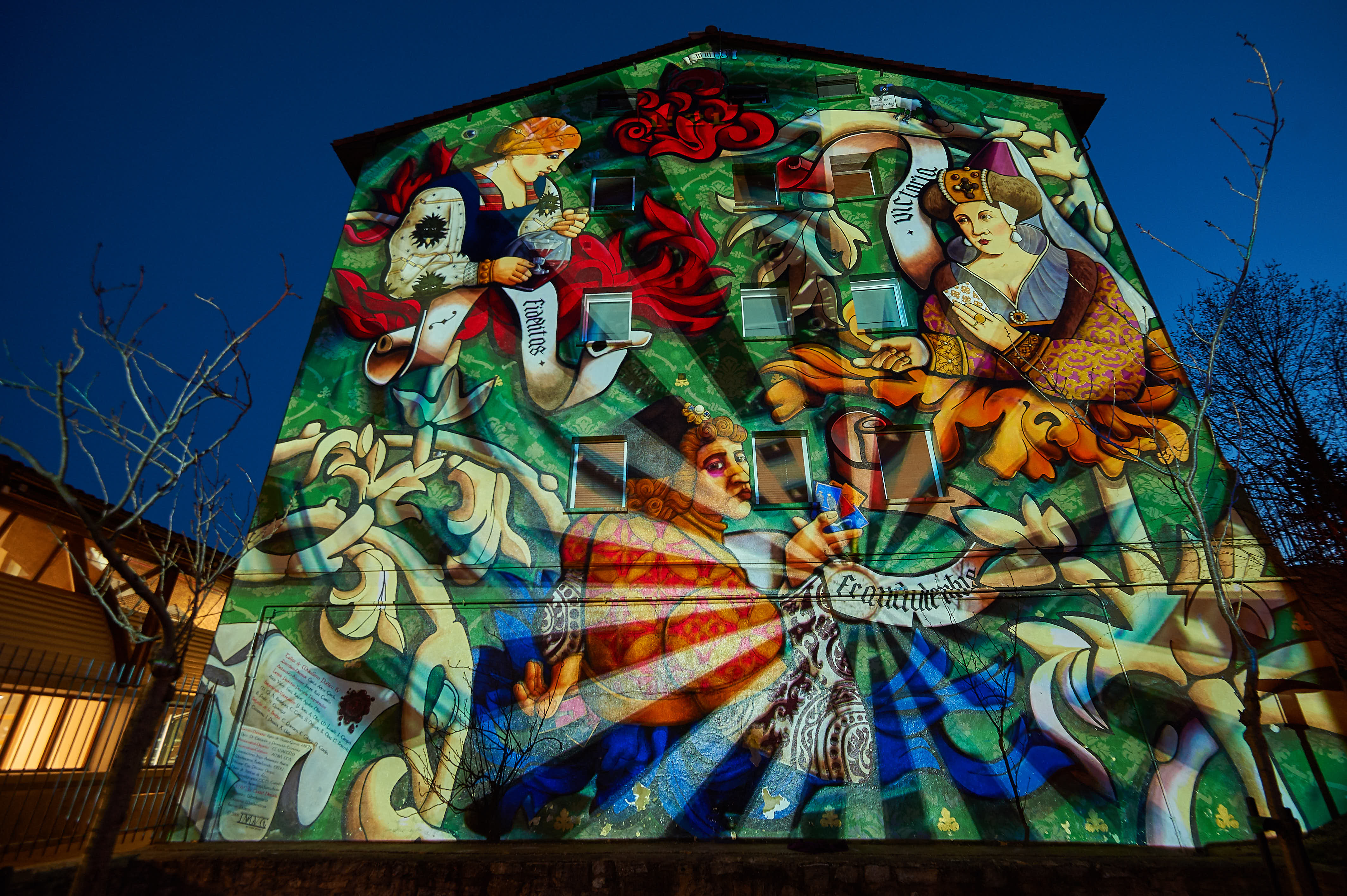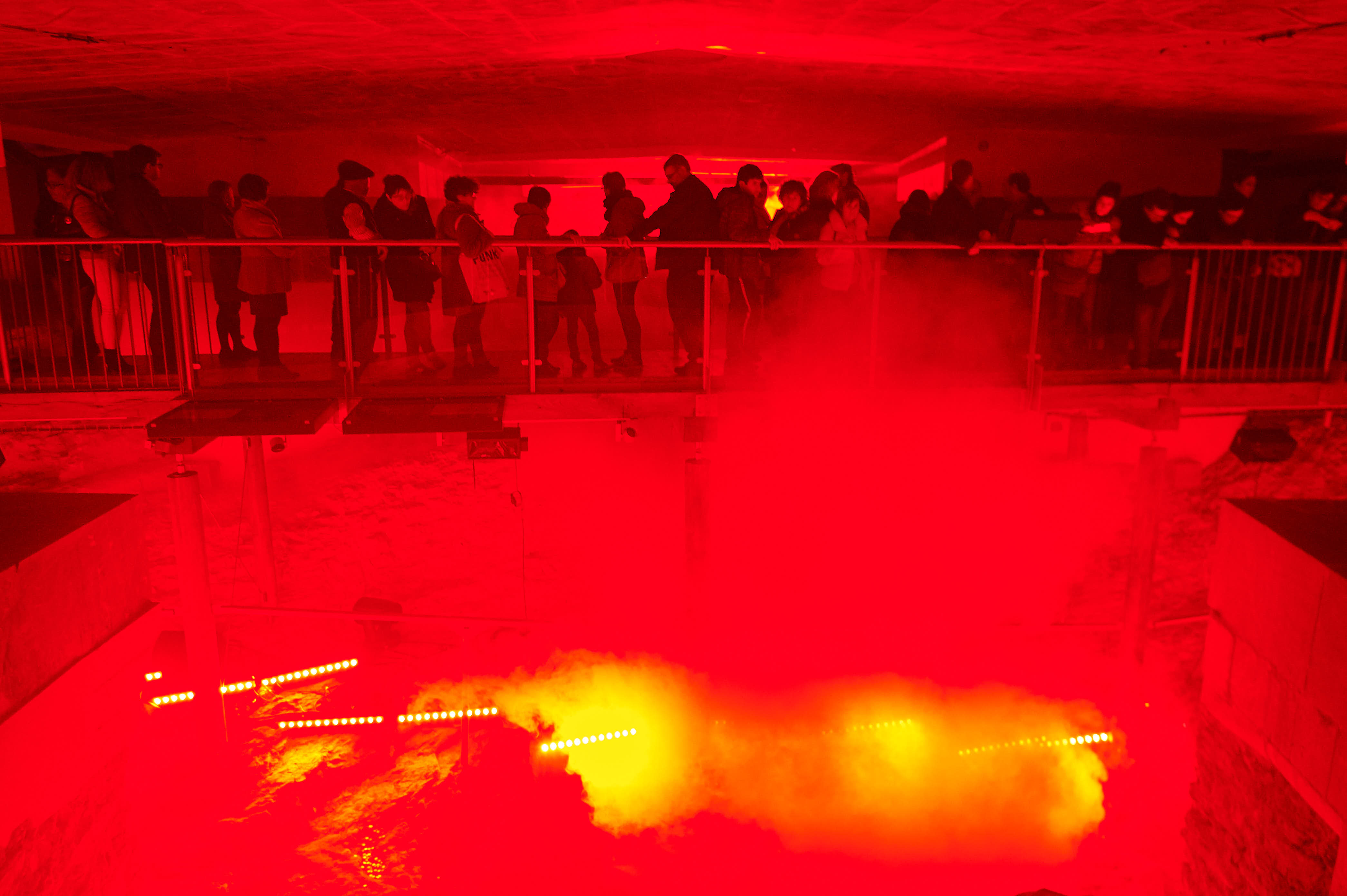A New Festival of Light in Spain
_ In northern Spain, the UMBRA Light Festival took place. From February 21 to 23, 2019, Vitoria-Gasteiz was the perfect stage for its first edition. The festival of light allowed us as visitors swiftly to understand the assets of the city. Like many of the other European festivals of light, the success of this new festival of light is based on altering of city sights and audience experiences of urban contexts.
Over the last 25 years, festivals of light have provided a broad variety of opportunities of socio-cultural gatherings and public celebrations of light reactivating cities by night. As well, they developed to be transdisciplinary displays of architects, designers and artists working with physical light as material, medium or metaphor. The UMBRA curators have been frequently visiting European festivals and developed a new format with their own twist for Vitoria-Gasteiz.
UMBRA Vitoria-Gasteiz 2019. Photo Nacho Arias.
Vitoria-Gasteiz is the seat of the government and the capital city of the Basque Autonomous Community and of the province of Araba/Álava. After Bilbao, it is second in size with 245.000 inhabitants. Life expectancy is said to be among the highest in the EU and in the world. The parameters are linked to life qualities and to the economic, social and health resources _ 1. The most important industrial activities are metal-working and mechanical engineering, auto, railway, and aeronautic industries, rubber and plastic production. Despite rapid population growth that took the city from about 50.000 inhabitants in the 1950s to its current 245.000, Vitoria-Gasteiz grew along an urban development concept favoring parks, recreation areas and a diversity of habitats. The city is comprised of concentric circles, with the medieval “almendra” itself at center. The “Green Belt”, a semi-natural green area partially reclaimed from degraded areas, surrounds the center. The third circle is dominated by forestry and mountains _ 2.
Aitor Oñaderra y Elisa Rueda. UMBRA Vitoria-Gasteiz 2019. Photo Nacho Arias.
In 2012, it was the first Spanish municipality to be awarded the title of European Green Capital and it is consistently ranked as one of the 5 best places to live in Spain _ 3. The post-assessment report of “European Green City 2012” states that “Vitoria’s political consensus, technical work and public commitment were decisive factors in its success.” _ 4 The sense for the quality of life is present in daily life and makes Vitoria-Gasteiz a very attractive destination.
To develop a site- and context-specific festival of light requires a multi-faceted analysis of the city. This includes to reflect on its shapes and its infrastructure, its history, its culture and its citizens, its past and its contemporary tasks. Vitoria-Gasteiz has a lot to offer: From the Middle Ages to the 18th century, the layout of the streets and the population remained almost unchanged. And it was not until the late 18th century when growth required the expansion of the city outside. To solve the problem of the difference in height between the original kernel on the hill, and the plain below, arches were erected and the Plaza de España was built to transition from the old city to the 19th century neoclassical expansion of wide streets and gardens like the Parque de la Florida and the Plaza de la Virgen Blanca. On December 21, Vitoria-Gasteiz celebrates its medieval center with a night of candlelight titled “Noche de las velas”. After Christmas, UMBRA is the first large public activity in the annual calendar. For the premiere in 2019, around 84.000 visitors came to share the experience.
UMBRA was developed and produced by Rafael Gallego, Joaquín Pérez-Goicoechea and Carlos Torrijos. It is their first appearance as a curating and production collective. I visited UMBRA as an experienced curator who was curious to see what the “new” trio is up to. In 2016, we had met in the LUX Helsinki Symposium where they announced that they wanted to do “something new” in Spain. Two years later, they proved that they were serious. “UMBRA? Great people, great result”, said Ilkka Paloniemi, the curator of LUX Helsinki, “It was a dream to come true for the well-known trio and a big chance for the city to develop inspiring well-being by public art event. My estimation is that there will be 50% more audience next year because the beat of the jungle drum is heavy. We will see the rising international interest on the city and the Basque culture. My prediction is also a positive development in Basque light art.” _ 5
During the festival, we learned that the team had to develop, produce and to get the word out in less than three months. Due to their professional backgrounds and due to their research and travel over the last two years within the International Network of Festivals of Light (INFL), they were able to speed up the process that usually takes an average around 12 months. Supported by spring-like weather the audience came in large numbers and filled the streets of the medieval quarter in the city’s center. A peaceful and joyful atmosphere spread all around the festival grounds. Bars and restaurants were full, some even had to close early because they were not prepared for the event. UMBRA surprised the city.
Néstor Basterretxea _ Anna Rosa Rupp. UMBRA Vitoria Gasteiz 2019. Photos: Nacho Arias.
The project encompassed 20 sites, which I think is a good amount to visit in the four hours exhibition time every night. Let me start to describe some of the works that are likely to be overlooked but represent interesting aspects of the curatorial ambition.
In co-operation with the Talká Gallery, three “Cajas de Luz” (en: Boxes of Light) by Néstor Basterretxea (1924-2014) were shown. The lightboxes were built in 2010, three out of the series of five were on display. There were presented in the gallery’s windows facing the Plaza del Marqués de la Alameda. Gallerist Gorka Basterretxea is the son of the artist and made it possible to show the works which are part of the family’s collection. “The light boxes are rooted in the pixels of the television that provoke the image to decompose, to be distorted, which I take advantage of to take the photographs which I use for these montages and which I then structure in a geometric order.” _ 6, Néstor Basterretxea is quoted in the booklet accompanying the visit to the festival. The artist distinguished himself in the Basque cultural arena for his wide and varied work in different fields. He studied industrial design and for all his life, he worked on graphic and furniture design as well as on architectural and urban development projects. At the same time, he experimented with a wide range of techniques and forms of artistic expression, from drawing and painting to photography and film making. His first experimental short films date from 1963. Experimental works with TV imageries like the one of Néstor Basterretxea or the “Black Gates” series by Otto Piene and Aldo Tambellini are valuable to understand how the development of mass media in the 1960s led to new artistic opportunities. Most of these works are only rarely shown. To create new contexts to display and discuss works of artists from different times and cultures who are exploring and working with light and media as artistic material and medium is an ambition that I share with the UMBRA curators.
While Néstor Basterretxea is the oldest of the participating artists, German Anna Rosa Rupp is the youngest, but she has a similar background. She studies design at the University of Bremen and at the same time she is exploring artistic forms of expression. Mainly, she is working with analogue prints. She generates forms of colors and structures shaped by the material woods, cardboards and pigments as well as by printing techniques. Her artistic research is dedicated to the impact of the human hand. In her projection works, she inverses the adding-on-process of printing. Colors, structures and shapes of her digitalized prints are in a constant play of assembling and dissembling. Through the projection’s light, the architectural surface of “Pórtico de la Iglesia de San Miguel” adds an additional shaping layer. The “Iglesia de San Miguel” is one of the very first and most important churches in the old city, built by the Navarra King as a “royal church”.
The unique mix of analogue and digital interferences of Anna Rosa Rupp is the opposite of the large-scale architecture mapping by the artists’ collectives dlux and Oido on the adjacent plaza. What enthused thousands of visitors was a series of colorful clichés adapted to facades of “Plaza de Espana”. This is one of the few moments of the UMBRA experience where the too short time of development was rendered visible.
dlux and Oido. UMBRA Vitoria-Gasteiz 2019. Photos: Nacho Arias.
Members of the same collective, Jordi Bonet, Joan Rodón and Emilio Valenzuela, showcased their great qualities in smaller mappings on existing murals which can be found all over town. The mural “El Triunfo de Vitoria” is referring to the history of printing playing card decks in town which to date can be found in every Spanish household. With a great sense of humor, the artists transformed the existing imagery into a video game. The second site was the mural “Al Hilo del Tiempo” by Verónica and Christina Werckmeister which has been realized in 2006 _ 7. Its title “The Thread of Time” refers to the square it overlooks, which in medieval times was a market for fabrics and clothes. The mapping used the movement patterns of weaving and knitting, stitching and sewing to animate the mural. Traditional fabrics in lush folds seemed to float over the façade. The third mural chosen by the artists to work on is titled “#Kontrastafrika”. Its central figure is a playing child formed of photographs taken in Africa by Kike Gómez and Javier Corso. The projection was a collage of video footage thematizing poverty and violence, war and migration. In the interplay with the found figure and the building, the projection furthered the narration of the mural.
In the overall view, eight of the 20 projects were projection-based and five of them were mappings, i.e. architecture projections that match the outlines of a building and interact with them through graphics or imageries. For most of the audience, it seemed to be their first time to see large-scale architecture projections and the way they change the appearance of the known sites of the city. And it is these site and city-specific architecture projections that provided the opportunity to understand the curatorial leitmotif “Urbanism of Light – New City Scapes” of the first edition of the UMBRA festival.
Ezequiel Nobili _ Juan Gómez-Cornejo _ Studio&Light. UMBRA Vitoira-Gasteiz 2019. Photo: Nacho Arias.
Three further site-specific installations were done by Ezequiel Nobili, Juan Gómez-Cornejo and Studio&Light. One was for the memorial of the former city wall, one for the crypt of the “Catedral de Santa Maria” and the third one was for the former water deposit “Depósito de Aguas”.
Ezequiel Nobili chose to work on the old city wall. The defensive walls of old Gasteiz were built between the years 1050 and 1100, even before the town of “Nova Victoria” founded in 1181. It was intended to be a defensive outpost on top of a hill at the site of the previous settlement of Gasteiz. About half of the total volume of the wall has been preserved and is being recovered since the beginning of the 21st Century. Behind the “Iglesia de San Miguel”, 160 meters of the non-preserved part of the wall is mimicked by a wooden grid. Ezequiel Nobili, founder and director of the nationally known collective “Don Lucero” in Madrid, utilized stage lighting tools and fog to visualize the light travelling through the wooden grid. Through the beams over the former moat, colored light travelled into the upper part of town and created a poetic atmosphere.
“I strive to do my work as part of a team and with the spirit of searching for new elements in the language of light, always investigating what the circumstances permit.” _ 8, stated Juan Gómez-Cornejo, an experienced and nationally known stage lighting designer. He developed a light-and-sound environment to illustrate the history of the former cemetery under crypt of the “Catedral de Santa Maria”. The church of Santa María collapsed due to a fire in 1202. It was rebuilt at the same site as a fortress-church to serve for religious services and as weapon storage. Over the centuries the building has been altered but kept its function being the heart of the medieval city. Today, there is an exhibition and a guided tour elucidating the intertwinement of the church’s and the city’s history. Visiting the exhibition, one can find the ab explanation for the coins that have been found in the graves under the cathedral. Those, mainly found in the mouth or the face of the deceased, were intended to be given to “Caronte”, the ferryman of Hades to pay for the passage from life to the realm of death. The light-and-sound design done with theater equipment referred to these dramatic moments of transition.
“Juan Gómez-Cornejo try to point that “the payment to Caronte” was not only in the old Greece, but we have new “Carontes”, who charge “a coin” what is really a big amount of Euros to cross the present “Arqueronte river” what is the Mediterranean.
For that reason He chose some parts of Mozart’s Requiem and mixed it with Arabic music”, explained Rafael Gallego.
The second underground space was the former water reservoir next to the “Palacio Montehermoso”. The 16th Century Renaissance building is linked to the water reservoir by an underground corridor which was added in 1885. Since 1991, it serves as a cultural center _ 9. During the UMBRA festival, the audience was invited to use the underground corridor to access to the 1.365 m² large hall of the former water reservoir _ 10. We arrived at a light-and-sound scenography based on vertical LED lines soaring from the floor. The leitmotif of the intervention was the rise and fall of the water in the tank. It was realized by Studio&Light, a lighting and design studio founded in Madrid in 2015 by Carlos Torrijos.
One of the characteristic features of the UMBRA Light Festival is the interaction of innovative technology and heritage sites. UMBRA is a great model of temporary interventions that respond to the parameters of promoting an “experimental” paradigm in cultural heritage. It was recently, in December 2018, when Vitoria-Gasteiz hosted a European conference titled “Cultural Heritage: Innovating on Past and Future”. The conference aimed to explore different perspectives on cultural heritage understood as a social and creative ecosystem. It addressed sociocultural mediation and inclusion, trans-disciplinary explorations and dialogic interventions in co-operation with creative economies. It resulted in a manifest defining policies. These were perfectly matched by the UMBRA Light Festival.
Chevalvert _ Philippe Morvan _ Playmodes _ Studio&Light. UMBRA Vitoria-Gasteiz 2019. Photo Nacho Arias.
Four installations for iconic sites of the medieval city were based on serial concepts. French Philippe Morvan used incandescent lamps, Studio&Light worked with Neon, the material of French collective Chevalvert and the collective Playmodes were LEDs. Serial art explores the aesthetics of series, repetitions and variations of the same object, theme or through a system of constant and variable elements or principles. The individual objects are organized by rules, often with the idea that theoretically these rules can be continued indefinitely. “If you look at the works of all the artists who were directly or indirectly involved in ZERO, you can see that they all work serially. And nobody has made compositions. It was the same with the musicians of that time. Whether it was John Cage, Karlheinz Stockhausen, Steve Reich or Philip Glass – you will find pure serial structures in all of them! It really electrified us that instead of composition, we now have structures, energy fields, grids and serial sequences.” _ 11, the artist Heinz Mack describes in retrospect light-and-sound-based artistic approaches since the 1950s. “The interplay of the minimum of means and the maximum of creativity makes is very eye- and ear-opening”, explains the composer and musician Bradford Catler when discussing the interest in serial practices. _ 12
While “Dot” by Philippe Morvan and “Renacer” by Studio&Light were closed circuits of light and sound, “Zootrop” by Playmodes responded to the live music played in the gazebo in the “Parque de la Florida” and “Stratum” by Chevalvert on the “Euskaldun Berriaren Plaza” next to the “Palacio Escoriaza-Esquivel” staged hand gestures of the audience as “momento movens” of a field of lights. All four works were well positioned. They highlighted the assets of the sites and vice-versa, the sites the artworks.
UMBRA Vitoria-Gasteiz 2019. Photos: Nacho Arias.
There were two projects that included the citizens of Vitoria-Gasteiz in the new festival in town. The “Escuelas de Artes” presented an associative series of slides of colors, shapes and structures observed in their daily practice. The windows of the entire building were colored to frame the slide-projection. Rafael Galego explains their motivation: “There is communication missing between the school’s activities and the general public. For that reason they decide to do an action “to open windows” to the city and showing the many things what they do (teaching and learning) with a spectrum of colored light coming from the interior in the windows. And the retro projected photos of students’ work in the door.
The performance was done by students and teachers, no lighting professionals were involved.”
UMBRA Vitoria-Gasteiz 2019. Photos: Nacho Arias.
And then there was an open invitation during the festival to observe the stars. More than 2.000 people came to see the stars and astronomers suffered because of the great reception of this activity. What seems to be a simple thing to do, has become a parameter of urban lighting quality. In times of “light pollution” and “sky glow”, the excessive use of artificial light by night prevents the visibility of the dark sky. One of the building blocks of the city’s green strategy beyond 2012 is to generate a masterplan to improve public lighting with “starlight” criteria _ 13. While streets and walkways are well lit, the sky over Vitoria-Gasteiz appears to be dark. This allows one of the activities of the UMBRA Light Festival to be a night sky observation. And maybe, this is why the curatorial team choose to name the festival UMBRA? The term “umbra”, Latin for “shadow”, refers to the darkest part of a shadow where the light source is completely blocked by the occluding body. Nevertheless, UMBRA proves that a light festival, if carefully curated, can foster awareness and care for the ecological interplay of natural and artificial light _ 14.
All the invited artists have a background through experience or training in architecture, design and media. None of them are rooted in fine art research and studies. The choice of artists mirrors the background of the curators. Joaquín Pérez-Goicoechea is an architect, Rafael Gallego is an architectural lighting designer and Carlos Torrijos is a stage lighting designer. Their knowledge and experience allow them to understand the interplay of the built environment, collective memory and community values. All works profited from the curators’ ambition to stage the interplay of urban sites, light and sight.
As well, local networking and co-operation seemed to work in a great way. “One of the unique features of a citywide light festival that it can cause a huge amount of problems, and requires the city to be heavily involved and to support the curators in developing and installing the artworks. Here in Vitoria-Gasteiz, the partnership seems to have been very successful”, states Keith Watson, experienced curator of WINTER LIGHTS CANARY WHARF in London. “Like other curators of light festivals, I visited the UMBRA Light Festival in February. For the three curators to go from zero to 100% presenting a new light festival, with no previous experience of doing it, is an amazing feat of bravery and great ambition, or probably some people would think stupidity!. To pull it off successfully with no danger, no damage, no major accident, (as far as I know) is even more extraordinary. As a curator and organiser myself, I would think twice about doing it in a new city, and a city which has never had an event like this before. I look forward to the next edition :)”_ 15
The participating artists included one female, five male and seven collectives from Spain, France and Germany. In 2019, we really shouldn’t need to refer to gender inequality, but as it is prevalent in the contemporary art world, we all may need to keep an eye on it in our curatorial choices. There are good artists and approaches out there, not to be missed.
Among the local festivals of Vitoria-Gasteiz, UMBRA fits like a missing link. So far, among the major public gatherings are religious festivals, music festivals and the annual TV festival, presenting programs and stars of National TV. There are two religious festivities anchored in the city’s annual calendar that are the “San Prudencio’s Festival” dedicated to the patron saint of the region Álava and the “Fiestas de la Virgen Blanca” honoring the patron saint of the city. The programs are clusters of public activities, including free open-air concerts. Since 1977, every July, the “Festival de Jazz de Vitoria-Gasteiz” is an international meeting point of the jazz-scene _ 16. Since 2002, every June it is time for the “Azkena Rock Festival”, nationally known for its international line-ups and atmosphere _ 17. Since 2007, every August, the festival “Curso International des Música” focusses on classical music _ 18. The UMBRA Light Festival is a new transdisciplinary stage for visual arts in Vitoria-Gasteiz, in the country and on the international map of festivals of light. The layout of the city with its series of plazas and extended walking areas are a perfect backdrop for a sociocultural event that asks visitors to walk and (re-)discover the city. Vitoria-Gasteiz with its historic layers, its life qualities and his present ambitions offers a perfect framework for working with light as the innovation driver of the 21st Century. The guiding curatorial interests, the quality of production and the care for the audience were more professional than could be expected from a brand-new activity developed and realized over the course of three months. Respeto, mis queridos colegas!
SOURCES
1 _ Vitoria-Gasteiz City Council: City and Economy: The City.
URL https://www.vitoria-gasteiz.org/wb021/was/contenidoAction.do?idioma=en&uid=u2bc01267_14693a5a13d__7fc7 seen on 21 February 2019.
2 _ European Commission: European Green Capital: 2012: Vitoria-Gasteiz.
URL http://ec.europa.eu/environment/europeangreencapital/winning-cities/2012-vitoria-gasteiz/ seen on 21 February 2019.
3 _ en.wikipedia.com: Vitoria-Gasteiz.
URL https://www.wikiwand.com/en/Vitoria-Gasteiz seen on 22 February 2019.
4 _ European Commission: European Green Capital: 2012: Vitoria-Gasteiz. Post-assessment Report. Page 5.
URL http://ec.europa.eu/environment/europeangreencapital/wp-content/uploads/2011/04/VG-Green-Conclusiones.pdf seen on 21 February 2019.
5 _ Ilkka Paloniemi visited UMBRA as part of an international collective of curators of the International Network of Festivals of Light. Quote by text to Bettina Pelz. Received on 12 March, 2019.
6 _ “Las cajas de luz están basadas en los píxeles de la televisión que provocan que la imagen se descomponga, se distorsione, lo que aprovecho para sacar fotografías que me sirven para hacer estos montajes a los que después estructutro dentro un orden geometrico“.
Translated by Bettina Pelz, supported by deepl.com. Done on 24 February 2019.
7 _ itinerario muralístico: Al Hilo del Tiempo. 2006.
URL http://www.muralismopublico.com/p/es/murales/vitoria-gasteiz/al-hilo-del-tiempo-2007.php seen on 1 March, 2109.
8 _ La Asociación de autores de iluminación (A.A.I.): Gómez-Cornejo, Juan: “Trato de acometer mis trabajos en equipo y con espíritu de encontrar nuevos elementos en el lenguaje de la luz, investigando siempre que las circunstancias lo permiten.”
Translated by Bettina Pelz, supported by deepl.com. Done on 1 March 2019.
URL https://adadi.org/socio-aai/gomez-cornejo-juan/ seen on 24 February 2019.
9 _ Centro Cultural Montehermoso: The Building.
URL https://www.montehermoso.net/pagina.php?m1=2&m2=31&id_p=2284 seen 26 February 2019.
10 _ Centro Cultural Montehermoso: Old Water Tank (Virtual Tour).
URL https://www.google.es/maps/@42.8486624,-2.672115,3a,75y,78h,90t/data=!3m6!1e1!3m4!1sZY8K6iyMdCsAAAQvO0fJ0w!2e0!7i13312!8i6656 seen on 26 February 2019.
11 _ im Ackermann: Zero-Kunst – „Wir hatten einfach keine Vorbilder mehr!“. Zeit Online 31.3.2015. URL http://www.zeit.de/kultur/kunst/2015-03/zero-kunst-avantgarde-heinz-mack/komplettansicht seen on 27 February 2019.
12 _ Thanks to Bradford Catler for the English corrections.
13 _ Vitoria-Geasteiz City Counsil: Beyond 2012 – Projects.
URL https://www.vitoria-gasteiz.org/wb021/was/contenidoAction.do?idioma=en&uid=u_6cbfe3b3_13381a23c52__7f9b seen on 22 February 2019.
14 _ Don’t be mistaken by the apparently lit sky in the press image of the observation. It just proves that the camera catches something different than the human eye.
15 _ Keith Watson Quote by email to Bettina Pelz. Received on 12 March, 2019.
16 _ Website of the “Jazz Festival des Vitoria-Gasteiz”.
URL https://www.jazzvitoria.com/ seen on 21 February 2019.
17 _ Website of the “Azkena Rock Festival”
URL https://www.azkenarockfestival.com/en/ seen on 21 February 2019.
18 _ Website of “Curso International de Música”.
URL http://www.vitoriamusic.com/ seen on 21 February 2019.

